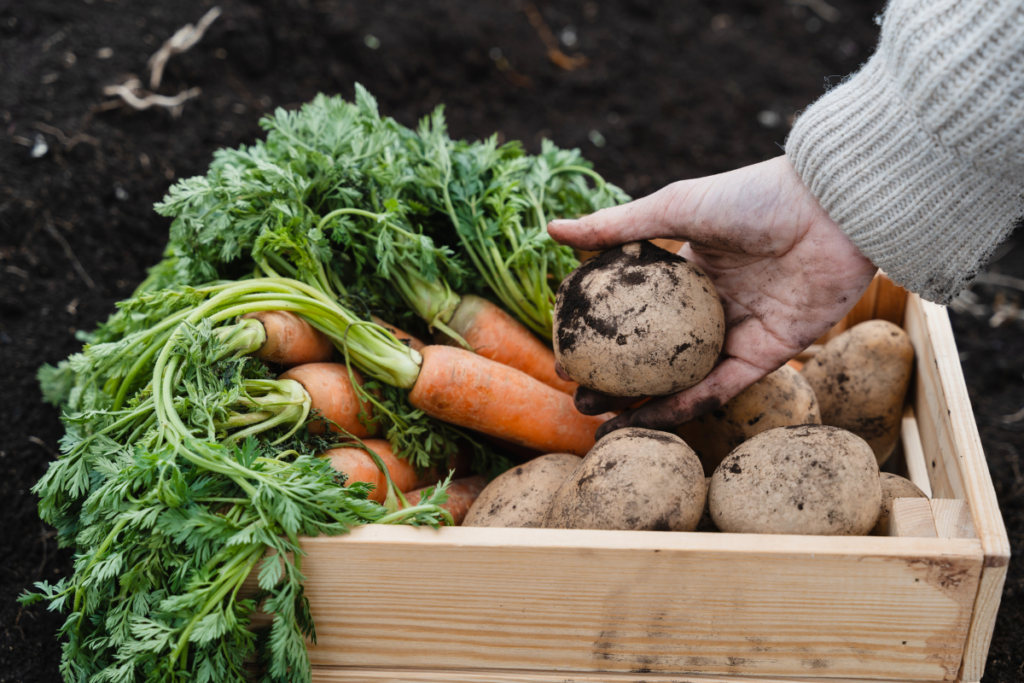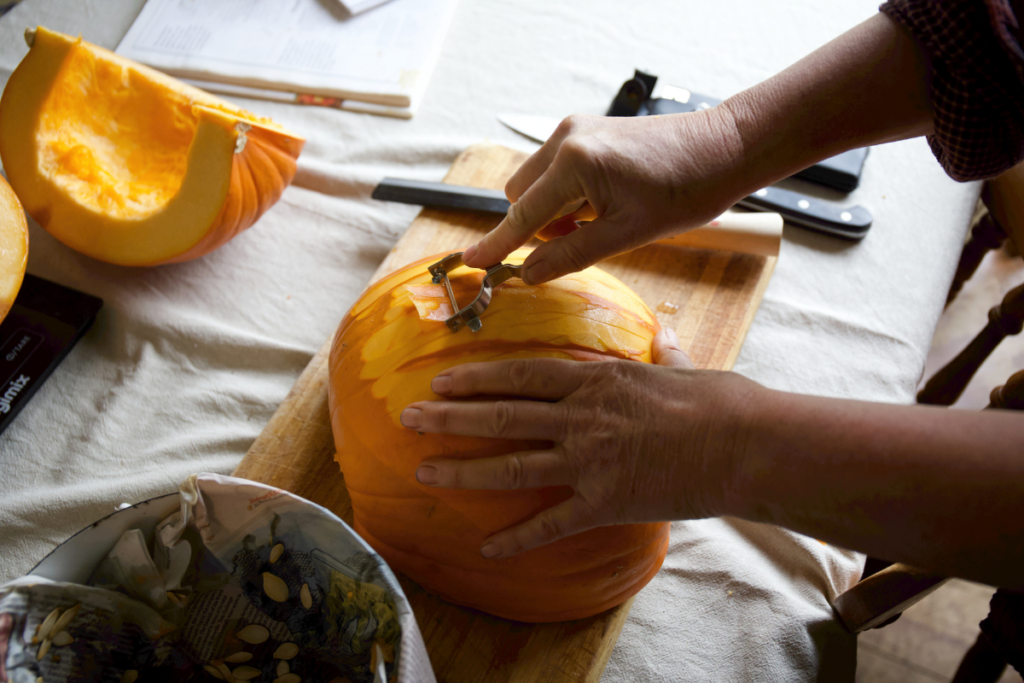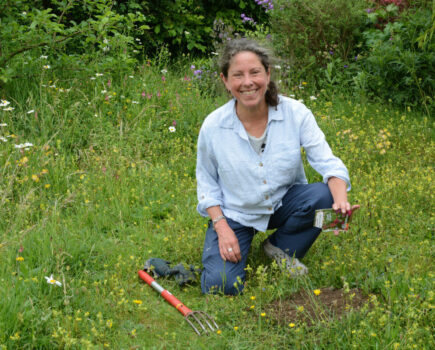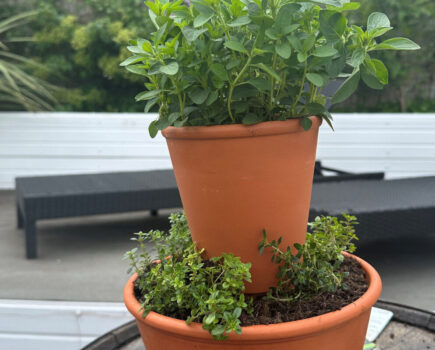This month, Stephanie Hafferty shares versatile meal ideas with squash and other veg harvests
There’s a hint of autumn in the air now, especially in the morning when I can smell the changing of the season on the breeze. Sensing the shortening days, the wild creatures that share my garden with me are busily laying down stores and fat reserves for the cold months ahead.
I leave windfall apples on the ground to biodegrade naturally, food for wasps and red admiral butterflies as well as many grubs. The insects in turn provide food for the birds that forage here by day, and the hedgehogs at night.
It is time to sow salads, spring cabbages, herbs and oriental greens to overwinter in a polytunnel or under cloches. Transplants sown in late July/ early August are ready to go out in the gaps that appear as summer crops finish.
If you’re not going to use a bed now until the following spring, leave plant material on the surface to gradually break down, protecting and feeding the soil. This technique, known as ‘chop and drop’, can be a slug magnet so I don’t use it where annual veg are growing, but it is an excellent free way of mulching and protecting the soil over winter.
September is a time of harvesting and preserving, laying down our own stores. Regularly check squash for signs of maturity – the stems will be hard and cork-like. Do the thumb nail test: if you can’t push your thumb nail in the stem, it is ready to harvest. Cut from the vine with the stem in a T-shape, and bring indoors to a sunny windowsill to cure for two weeks before storing. This enables the skin to mature, and means the squash should keep for many months ahead.
Damaged squash won’t store well, so bring any with nibbles or nicks into the kitchen to use now. Cooked squash freezes well, or turn into preserves such as squash jam or pickled squash.
………………….
Winter squash vegetable traybake with spicy harissa tahini sauce

Seasonal vegetable tray bakes are a fantastic way of using up the contents of the fridge and vegetable basket and maximising your oven space, saving energy and money and reducing food waste.
One of the joys of this kind of recipe is that it does not need accurate measurements. I usually keep on chopping until the trays are filled with veg. Leftovers offer so many possibilities that I always cook more than we need for the meal (see end of recipe for ideas). The addition of white beans makes this a complete meal.

Ingredients
Makes enough for a meal for 4, plus leftovers
2 small or 1 medium-sized winter squash
2 red or yellow onions (or 2 or 3 large leeks)
1kg root veg eg: carrots, potatoes, parsnips, swede, sweet potatoes
1 large broccoli head (alternatives a few handfuls of Brussels sprouts or sprouting broccoli)
2 X 400g tins of butter beans, drained
6 tbsp oil – olive, sunflower or rapeseed
Salt and pepper
chopped fresh parsley or coriander to serve (optional)
For the harissa tahini dressing
Makes approx 400 ml
4 tbsp harissa paste
8 tbsp tahini
8 tbsp olive oil (or other light oil such as sunflower)
1 lemon – juice and zest
2 tbsp maple syrup or honey
1-2 garlic cloves, minced (optional)
salt and pepper
10-12 tbsp water
Method
Preheat oven to 180°C Fan/ 200°C/ gas 6
Dice all of the vegetables into bite sized pieces and place on large roasting tins. Add the butter beans.
Drizzle over the oil and mix with your hands to coat the vegetables. Season well with salt and pepper. Put in the oven and roast for 45 minutes, turning half-way through cooking.
Meanwhile, make the dressing.
Place all of the sauce ingredients except the water in a jug and blend using an immersion blender. Add water a tablespoon at a time until the consistency is like pouring cream. Season to taste.
Serve warm with freshly chopped parsley or coriander, and the dressing drizzled on top.
…………..
Hints, tips and variations
Almost all veg works well in this recipe, making it a truly year round traybake. Reduce cooking time for softer veg eg: aubergine, tomatoes, courgette, summer squash
Use cooked homegrown white runner beans or borlotti beans instead of tinned.
For a meaty version replace the beans with chicken thighs, meat balls, chorizo or sausages.
For a cheesy version, replace the beans with halloumi cut into strips.
…………
Stephanie’s top squash tips
To peel or not to peel?

All squash skin is edible, and it is rich in nutrients, but some are more palatable than others. Butternut, acorn, delicata and uchiki kuri (aka onion) squashes have skins which are delicious to eat when cooked. Squash with tougher skins are better peeled for recipes like this, otherwise the chewy texture can spoil the recipe.
What to do with squash seed
Squash seeds are edible: toss in oil and salt, and roast in a single layer for 15 minutes until lightly browned.
Squash cross-pollinate widely and unless you have followed strict isolation procedures, it really isn’t worthwhile saving them for next year’s seed. Eat, or pop on the bird table for the wild things to munch instead.
…………………..
Lovely leftover ideas
Vegetable soup

Place 1kg (2.2lbs) of cooked vegetables in a large pan with 750ml (26 fl oz) stock or water. Simmer for 5-10 minutes until the veg is cooked through. Season with salt and pepper. Either serve chunky, or puree using an immersion blender.
Frittata
Beat together 8 eggs with a few tbsp double cream, 100g (3.5oz) grated cheese and season with salt and pepper. Add a small handful of chopped parsley and a few handfuls of cooked veg. Mix together and pour into an overproof dish. Cook for 30 minutes at 180° fan until the eggs are set.
Roast veg salad
Serve leftover veg with autumn salad greens and your favourite dressing. Sriracha mixed with mayo is good.
For more recipe, gardening and course information from Stephanie see nodighome.com
Find more tips, advice and articles like this at the Amateur Gardening website. Subscribe to Amateur Gardening magazine now





